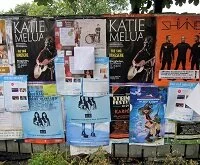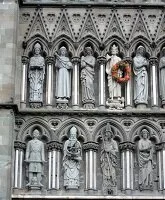However, by the time the political scene finally settled down, the Hanseatic League had already gained hold in Bergen as they established a monopoly on trade to and from the region, forcing all trade to go through Bergen. Trondheim received a further blow in about 1300 when the capital was moved to Oslo.
Despite the losses of power in the 1200 and 1300s, Trondheim maintained power in the form of the Catholic Church, who had its base in Norway centered in Trondheim. This last bit of power and influence was lost with the introduction of Protestantism in 1537. Since this time the city has fallen numerous times, primarily due to fires that have destroyed the city throughout the centuries.
The city again fell in 1940 during World War II to the Germans, who made the city a submarine base. Since the end of World War II Trondheim has continued to struggle politically and economically as those sectors have shifted to or remained in other cities. However, Trondheim has more recently become a thriving university city full of life, creativity, and is a growing cultural center.
Trondheim Today

Posters in Trondheim
Despite the incredible past as the capital of the Vikings, Trondheim today is a fairly modern city that feels more focused on the present and future than the past. About 20% of the city is made up of students, giving the city great energy and excitement. These students also dictate the city's entertainment, culture, and lifestyle as bars, restaurants, music venues, and sports venues are all in or near the city.
In part due to these students, the city is also a great sports destination. Being so accessible to nearby lands and incredible landscapes skiing is popular just outside the city limits and water activities like sailing are also common.
Historical & Architectural Sights
 Archbishop's Palace Museum (Museet Erkebispegården): This building was the home to the city's Archbishop from the time of its construction in the 1100s until 1537 when Catholicism was replaced with Protestantism in Norway. The building is the oldest secular building in Norway and is very impressive; in addition to the structure itself, it is also home to a number of religious and historical exhibits. For more information visit their website at: www.nidarosdomen.no/en-GB/archbishops+palace.
Archbishop's Palace Museum (Museet Erkebispegården): This building was the home to the city's Archbishop from the time of its construction in the 1100s until 1537 when Catholicism was replaced with Protestantism in Norway. The building is the oldest secular building in Norway and is very impressive; in addition to the structure itself, it is also home to a number of religious and historical exhibits. For more information visit their website at: www.nidarosdomen.no/en-GB/archbishops+palace.
 Kristiansten Fortress (Kristiansten Festning): This fortress (1681-1684) protected the city for a couple centuries, but today only serves as a tourist sight overlooking the city.
Kristiansten Fortress (Kristiansten Festning): This fortress (1681-1684) protected the city for a couple centuries, but today only serves as a tourist sight overlooking the city.
 Monk's Islet (Munkholmen): This island has been home to monks as the name would suggest, but it has also served as a fortress, prison, and a Nazi gun station during World War II. Today it makes a pleasant day trip to see both the island as well as views of Trondheim from the water.
Monk's Islet (Munkholmen): This island has been home to monks as the name would suggest, but it has also served as a fortress, prison, and a Nazi gun station during World War II. Today it makes a pleasant day trip to see both the island as well as views of Trondheim from the water.

Details on Nidaros Cathedral
 Nidaros Cathedral (Nidarosdomen): This is Norway's most sacred and important church as it was built over the grave of St. Olav, who helped convert the people to Christianity in the 1000s. It was here that most Norwegian kings were coronated and crowned and many are also buried in the church. From the church's founding in 1070 it has been continuously expanded and re-built over time as renovations seem common even today. For more information visit their website at: www.nidarosdomen.no/en-GB/nidaros+cathedral.
Nidaros Cathedral (Nidarosdomen): This is Norway's most sacred and important church as it was built over the grave of St. Olav, who helped convert the people to Christianity in the 1000s. It was here that most Norwegian kings were coronated and crowned and many are also buried in the church. From the church's founding in 1070 it has been continuously expanded and re-built over time as renovations seem common even today. For more information visit their website at: www.nidarosdomen.no/en-GB/nidaros+cathedral.
 Royal Residence (Stiftsgården): The Royal Residence (1774-1778) is the largest wooden palace in Norway, and today is the official residence of the royal family when in Trondheim. For more information visit their website at: www.nkim.no/stiftsgarden (Norwegian only).
Royal Residence (Stiftsgården): The Royal Residence (1774-1778) is the largest wooden palace in Norway, and today is the official residence of the royal family when in Trondheim. For more information visit their website at: www.nkim.no/stiftsgarden (Norwegian only).
Monuments
 Statue of Leif Ericson: This replica near the Customs Building pays homage to the famous Viking explorer, who was the first Europe to the Americas.
Statue of Leif Ericson: This replica near the Customs Building pays homage to the famous Viking explorer, who was the first Europe to the Americas.
 Statue of Olav Tryggvason: Standing in the city's central plaza, this statue honors Norway's patron saint.
Statue of Olav Tryggvason: Standing in the city's central plaza, this statue honors Norway's patron saint.
Museums, Arts, & Entertainment
 Archbishop's Palace Museum (Museet Erkebispegården): This building was the home to the city's Archbishop from the time of its construction in the 1100s until 1537 when Catholicism was replaced with Protestantism in Norway. The building is the oldest secular building in Norway and is very impressive; in addition to the structure itself, it is also home to a number of religious and historical exhibits. For more information visit their website at: www.nidarosdomen.no/en-GB/archbishops+palace.
Archbishop's Palace Museum (Museet Erkebispegården): This building was the home to the city's Archbishop from the time of its construction in the 1100s until 1537 when Catholicism was replaced with Protestantism in Norway. The building is the oldest secular building in Norway and is very impressive; in addition to the structure itself, it is also home to a number of religious and historical exhibits. For more information visit their website at: www.nidarosdomen.no/en-GB/archbishops+palace.
 Ringve Museum: This museum is the national museum of music as it boasts both historic and modern musical instruments, as well as modern props like lighting and other concert effects. For more information visit their website at: ringve.no/en/.
Ringve Museum: This museum is the national museum of music as it boasts both historic and modern musical instruments, as well as modern props like lighting and other concert effects. For more information visit their website at: ringve.no/en/.
 Rockheim: This is one of the city's newest attractions (opened in 2010) as it is home to the modern musical era, focused on rock, which lends its name to the museum. Most of the exhibits are for local artists, but the venue also has concerts and a restaurant with incredible city views. For more information visit their website at: www.rockheim.no/english/.
Rockheim: This is one of the city's newest attractions (opened in 2010) as it is home to the modern musical era, focused on rock, which lends its name to the museum. Most of the exhibits are for local artists, but the venue also has concerts and a restaurant with incredible city views. For more information visit their website at: www.rockheim.no/english/.
 Sverresborg-Trøndelag Folk Museum (Sverresborg i Trondheim): This partial open air museum is built on the ruins of a historic castle, but today is more well-known for the cultural exhibits and wooden structures that represent people of the city and region. For more information visit their website at: www.sverresborg.no/english/.
Sverresborg-Trøndelag Folk Museum (Sverresborg i Trondheim): This partial open air museum is built on the ruins of a historic castle, but today is more well-known for the cultural exhibits and wooden structures that represent people of the city and region. For more information visit their website at: www.sverresborg.no/english/.
 Trondheim Museum of Arts (Trondheim Kunstmuseum): This museum houses the third largest art collection in Norway and much of the pieces on display are by Norwegian artists. For more information visit their website at: trondheimkunstmuseum.no/?lang=en.
Trondheim Museum of Arts (Trondheim Kunstmuseum): This museum houses the third largest art collection in Norway and much of the pieces on display are by Norwegian artists. For more information visit their website at: trondheimkunstmuseum.no/?lang=en.
 Trondheim Science Museum (Vitensenteret i Trondheim): This museum is great for kids as many of the displays are hands-on interactive experiences. For more information visit their website at: www.vitensenteret.com (Norwegian only).
Trondheim Science Museum (Vitensenteret i Trondheim): This museum is great for kids as many of the displays are hands-on interactive experiences. For more information visit their website at: www.vitensenteret.com (Norwegian only).
Areas & Neighborhoods of Interest
The area centered on "Nordre St.," which includes the Olav Tryggvason Gate and the Thomas Angells Gate is the heart of the city as many of the streets are pedestrian and nearly every store front is a shop or restaurant. This is the best place to see and feel the pulse of the city.
Transportation
Trondheim is well connected domestically as they numerous transportation options. The city has one of the country's largest airports, which offer flights to all major Norwegian cities with a couple flights each day to large cities like Oslo and Bergen. The city is also a hub on the train lines as trains run north, south, and east on multiple lines. The city is also a fairly large passenger port city and most trains stop here on their trips along the coast. Buses are also a great way to get around, especially to many inland towns and cities that are not accessible by train lines; buses also service most large Norwegian cities.
International transportation to and from Trondheim is much more limited. The airport has a number of international routes, but primarily to nearby cities, such as Stockholm, London, and Berlin. The train lines heading east travel to Sweden, but due to the great distances, take some time.
 Airport: Trondheim's airport, Værnes Airport is located about 21 miles (34 kilometers) from the city's center. The airport code is TRD and the airport's website is: www.avinor.no/en/airport/trondheim.
Airport: Trondheim's airport, Værnes Airport is located about 21 miles (34 kilometers) from the city's center. The airport code is TRD and the airport's website is: www.avinor.no/en/airport/trondheim.
 Train Station: Trondheim's main train station is located on the water near the center of town. For train times and schedules, their website is: www.nsb.no. For its location or directions, see the map below.
Train Station: Trondheim's main train station is located on the water near the center of town. For train times and schedules, their website is: www.nsb.no. For its location or directions, see the map below.
 Bus Station: There are numerous private bus companies that service Trondheim. There are a couple bus stations and stops, but the main bus station is located next to the train station. For its location or directions, see the map below.
Bus Station: There are numerous private bus companies that service Trondheim. There are a couple bus stations and stops, but the main bus station is located next to the train station. For its location or directions, see the map below.
Local Transportation: Seeing Trondheim itself is best explored with the local bus system, which services most of the city as well as many of the suburbs. Additionally buses also run at night for those enjoying the city into the morning hours, but prices rise and routes are limited.
Official Websites
City of Trondheim: www.visittrondheim.no
Kingdom of Norway: www.visitnorway.com
Map & Directions